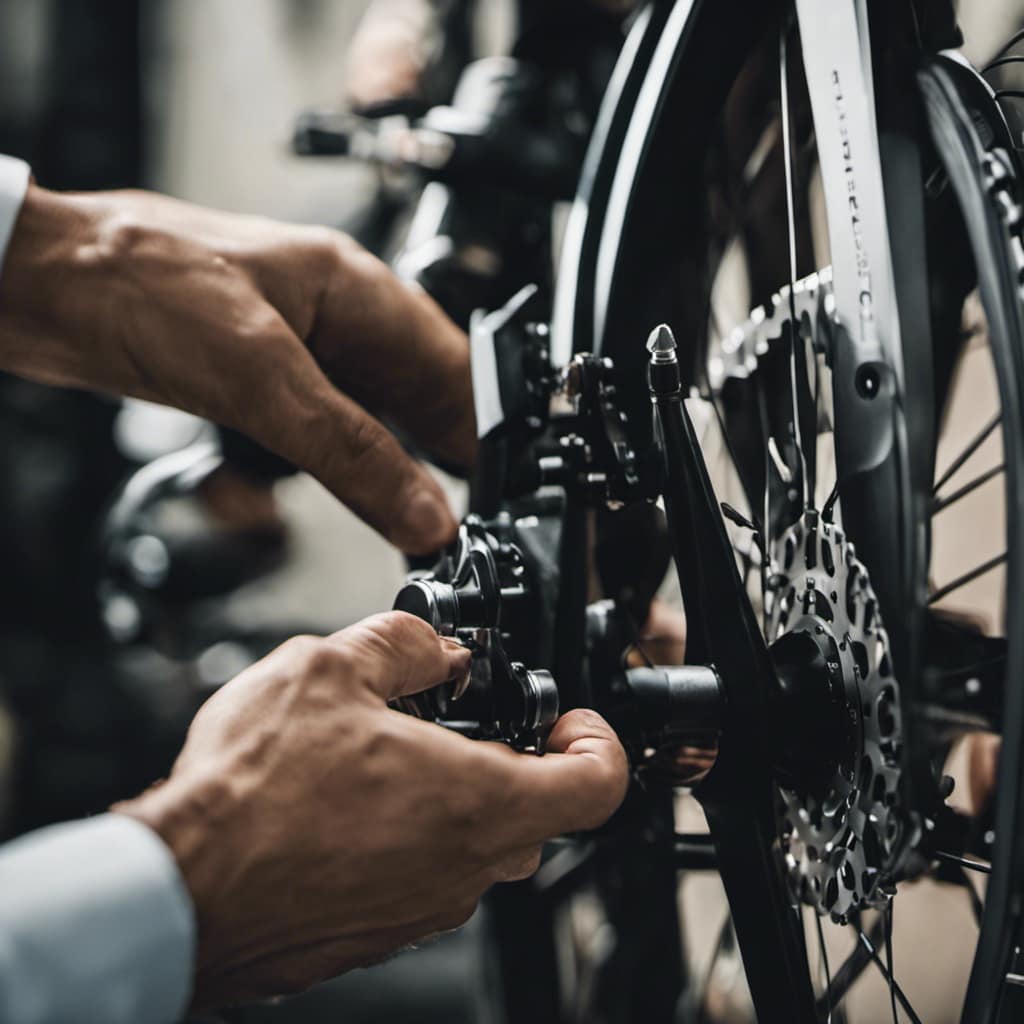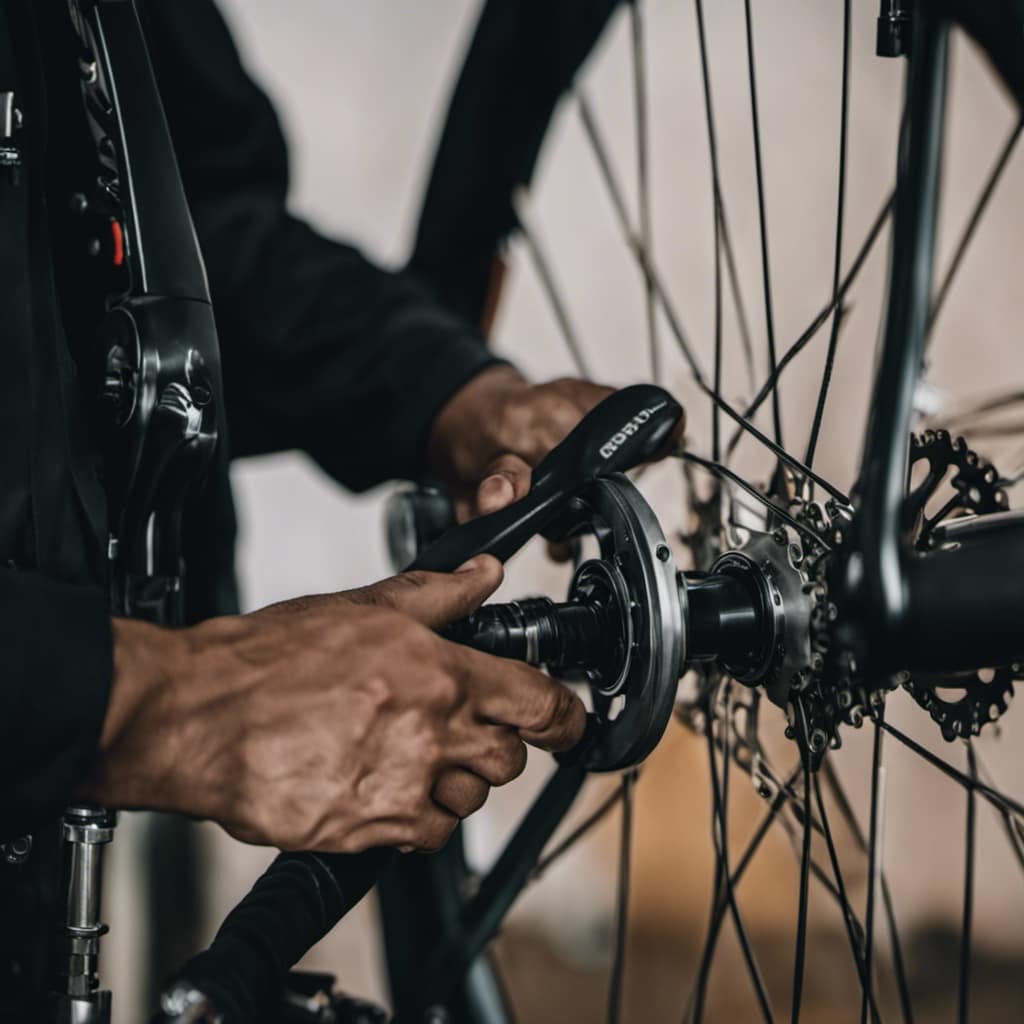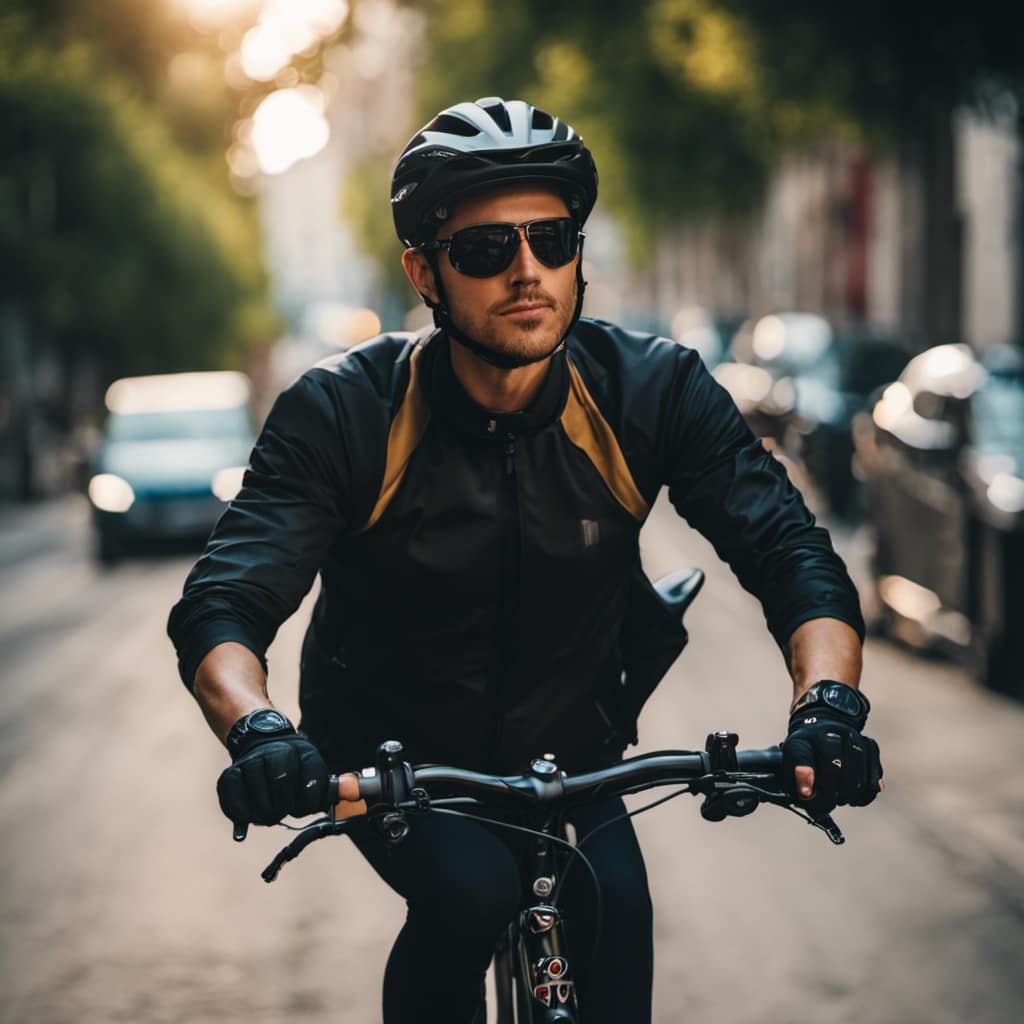Looking to hit the road on your commuter hybrid bike? We’ve got you covered with our top tips for ensuring cycling safety.
Strap on your helmet, because we’re about to navigate the world of traffic rules and signals, proper bike maintenance, and the importance of using lights and reflectors.
Don’t forget to don high-visibility clothing and stay mindful of road conditions.
With our expert advice on defensive cycling techniques and avoiding distractions, you’ll be liberated to ride with confidence.
Key Takeaways
- Choose a helmet with MIPS technology and integrated LED lights for maximum impact protection and increased visibility in low-light conditions.
- Familiarize yourself with and abide by traffic rules and signals to ensure safety on the road. Use hand signals and proper lane positioning to communicate intentions and navigate traffic.
- Regularly clean and maintain your commuter hybrid bike to ensure its components are in top condition and prevent accidents caused by malfunctioning parts.
- Invest in high-quality reflective gear and high-visibility clothing to increase visibility and reduce the risk of accidents.
Choosing the Right Helmet
We should always prioritize our safety by choosing the right helmet when cycling with commuter hybrid bikes.
Helmet fitting is crucial to ensure maximum protection. A well-fitted helmet should sit level on our heads, covering the forehead without obstructing our vision. It should fit snugly, with the straps securely fastened under the chin.
When it comes to helmet technology, advancements have revolutionized safety in cycling. Look for helmets with MIPS (Multi-directional Impact Protection System) technology, which provides added protection against rotational forces during an impact. Additionally, consider helmets with integrated LED lights for increased visibility, especially during low-light conditions.
Understanding Traffic Rules and Signals
As cyclists, we must familiarize ourselves with and abide by the traffic rules and signals to ensure our safety on the road. Understanding these rules and signals is crucial, especially in areas with high traffic congestion. By following the rules, we can navigate through traffic more efficiently and reduce the risk of accidents.
Sharing the road with other vehicles requires us to be aware of our surroundings and communicate our intentions through hand signals and proper lane positioning. Remember, we’ve the right to be on the road just like any other vehicle, but we must also respect the rights of others. By understanding and obeying traffic rules and signals, we can create a safer environment for all road users.
Now that we know how to stay safe on the road, let’s move on to the next important aspect, maintaining proper bike maintenance.
Maintaining Proper Bike Maintenance
To ensure the longevity and performance of our commuter hybrid bikes, it’s essential that we regularly maintain them. By following a bike maintenance checklist, we can keep our bikes in top condition and avoid common bike maintenance mistakes.
Firstly, we should regularly clean our bikes, removing dirt and grime that can damage the components.
Secondly, we should inspect the tires for any signs of wear or damage, ensuring they’re properly inflated for a smooth and safe ride.
Thirdly, we should regularly lubricate the chain and other moving parts to prevent rust and ensure smooth operation.
Lastly, we should check the brakes, gears, and other components for proper functioning.
Using Bike Lights and Reflectors
When it comes to cycling safety, using bike lights and reflectors is crucial. Our expert advice is to invest in high-quality reflective gear and choose bright bike lights that provide maximum visibility.
Importance of Reflective Gear
We always make sure to use bike lights and reflectors when cycling at night for added visibility and safety. Reflective gear is a crucial aspect of cycling safety, especially in low-light conditions. Here are four reasons why using reflective accessories is important:
-
Enhanced Visibility: Reflective clothing and accessories make you more visible to other road users, reducing the risk of accidents.
-
Increased Safety: Reflective gear allows drivers and pedestrians to anticipate your presence, giving them ample time to react and avoid collisions.
-
Peace of Mind: By wearing reflective gear, you can ride with confidence, knowing that you’re doing everything possible to stay visible and safe on the road.
-
Legal Requirement: In many places, it’s mandatory to have reflective gear when cycling at night. By complying with these regulations, you can avoid fines and promote a culture of safety.
Using reflective gear is just the first step towards ensuring cycling safety. Now, let’s explore the importance of choosing bright bike lights.
Choosing Bright Bike Lights
As cyclists, we prioritize our safety by selecting bright bike lights that ensure maximum visibility on the road. When it comes to choosing the right bike lights, there are several options available.
LED lights are highly recommended for their brightness and longevity. They come in various forms, including front and rear lights, as well as clip-on lights that can be attached to your helmet or clothing.
When installing bike lights, it’s important to position them correctly for optimal visibility. The front light should be mounted on the handlebars, while the rear light should be attached to the seat post or rear rack.
Additionally, consider using reflective tape or stickers on your bike frame and wheels for added visibility.
Wearing High-Visibility Clothing
When it comes to cycling safety, wearing high-visibility clothing is crucial. Reflective gear helps increase your visibility to drivers, especially in low light conditions.
Importance of Reflective Gear
Our safety on the road greatly depends on the visibility of our clothing while cycling. Incorporating reflective gear into our cycling wardrobe is crucial for ensuring visibility and reducing the risk of accidents.
Here are four reasons why reflective gear is essential for cycling safety:
-
Increased visibility: Reflective tape and accessories significantly enhance visibility, making it easier for motorists and pedestrians to spot cyclists, especially in low light conditions or at night.
-
Improved safety: Wearing high-visibility clothing reduces the likelihood of accidents by alerting drivers to the presence of cyclists in their vicinity. This helps to prevent collisions and promotes a safer cycling experience.
-
Peace of mind: Knowing that you’re easily visible to others on the road provides a sense of security and confidence, allowing you to focus on enjoying your ride without worrying about potential dangers.
-
Fashionable and functional: Reflective gear is now available in stylish designs that seamlessly integrate into your cycling wardrobe. You can stay safe while expressing your personal style and enjoying the freedom of cycling.
Safety in Low Light
At dusk, we should always wear high-visibility clothing to ensure our safety while cycling in low light conditions. Road visibility is crucial for both our protection and the awareness of other road users. By wearing reflective clothing, we significantly increase our visibility and reduce the risk of accidents. Reflective clothing is designed to reflect light, making us more visible to drivers and other cyclists. It is especially important during low light conditions, such as dawn or dusk when visibility is compromised. To emphasize the significance of high-visibility clothing, let’s take a look at this table:
| Low Light Conditions | Without Reflective Clothing | With Reflective Clothing |
|---|---|---|
| Dawn | Low visibility, increased risk | High visibility, reduced risk |
| Dusk | Low visibility, increased risk | High visibility, reduced risk |
| Night | Low visibility, increased risk | High visibility, reduced risk |
| Foggy conditions | Low visibility, increased risk | High visibility, reduced risk |
| Rainy conditions | Low visibility, increased risk | High visibility, reduced risk |
Wearing high-visibility clothing significantly improves our visibility, allowing us to be seen from a distance, even in low light conditions. By being mindful of road conditions and taking necessary precautions, we can ensure a safer cycling experience for ourselves and others. Now let’s move on to the next section and explore the importance of being mindful of road conditions.
Being Mindful of Road Conditions
One of the most important things we can do to ensure cycling safety with our commuter hybrid bikes is to be mindful of the road conditions. Here are four key tips to help us navigate the roads safely:
-
Stay aware of weather conditions: Checking the weather forecast before heading out can provide valuable information about potential hazards like rain, strong winds, or icy roads. Adjusting our plans accordingly can help us avoid accidents and stay safe.
-
Watch out for road hazards: Potholes, debris, and uneven surfaces can pose risks to cyclists. Keeping a vigilant eye on the road ahead and being prepared to maneuver around these obstacles can prevent accidents and injuries.
-
Be cautious in wet conditions: Wet roads can be slippery, reducing traction and making it harder to control our bikes. Slowing down, giving ourselves extra stopping distance, and avoiding sudden maneuvers can help us maintain control and stay safe in wet weather.
-
Adapt to changing road conditions: Road conditions can vary throughout our journey, so it’s important to stay adaptable. Being aware of changes in terrain, traffic, or construction zones can help us make split-second decisions to ensure our safety.
Practicing Defensive Cycling Techniques
To ensure our safety on the road, we can practice defensive cycling techniques such as anticipating potential hazards and maintaining visibility. Defensive cycling techniques are essential for road awareness and keeping ourselves safe while commuting on our hybrid bikes.
One important technique is to always be aware of our surroundings, constantly scanning for any potential dangers. This includes looking out for cars, pedestrians, and other cyclists. It’s also crucial to signal our intentions clearly, using hand signals to indicate turns and stops. By doing so, we communicate our intentions to other road users and reduce the risk of accidents.
Additionally, maintaining visibility by wearing bright clothing and using lights and reflectors on our bikes is crucial for ensuring that others can see us on the road.
These defensive cycling techniques will help us stay safe and enjoy our rides with confidence.
Staying Alert and Avoiding Distractions
We can stay alert and avoid distractions by prioritizing our focus and using techniques such as limiting phone usage while riding. Here are four important tips to help us maintain our attention and stay safe on our commuter hybrid bikes:
-
Stay aware of our surroundings: Keep our eyes on the road, constantly scanning for potential hazards such as parked cars, pedestrians, and other cyclists.
-
Avoid headphone use: Listening to music or podcasts with headphones can hinder our ability to hear approaching vehicles or warning signals. It’s crucial to be able to hear what’s happening around us to react quickly and prevent accidents.
-
Utilize hand signals: Signaling our intentions with clear hand gestures is essential for communicating with other road users, ensuring they understand our intentions and can react accordingly.
-
Stay focused on the road: Eliminate distractions like texting or browsing on our phones. By keeping our attention solely on the road, we can react swiftly to any unexpected situations and maintain our safety.
Conclusion
In conclusion, by following these top tips for cycling safety with commuter hybrid bikes, we can ensure a safer and more enjoyable ride.
Remember, accidents can happen, but with the right helmet, understanding traffic rules, proper maintenance, lights and reflectors, high-visibility clothing, mindfulness of road conditions, defensive cycling techniques, and staying alert, we can greatly reduce the risk.
So let’s gear up, stay safe, and pedal towards a worry-free commute!
















